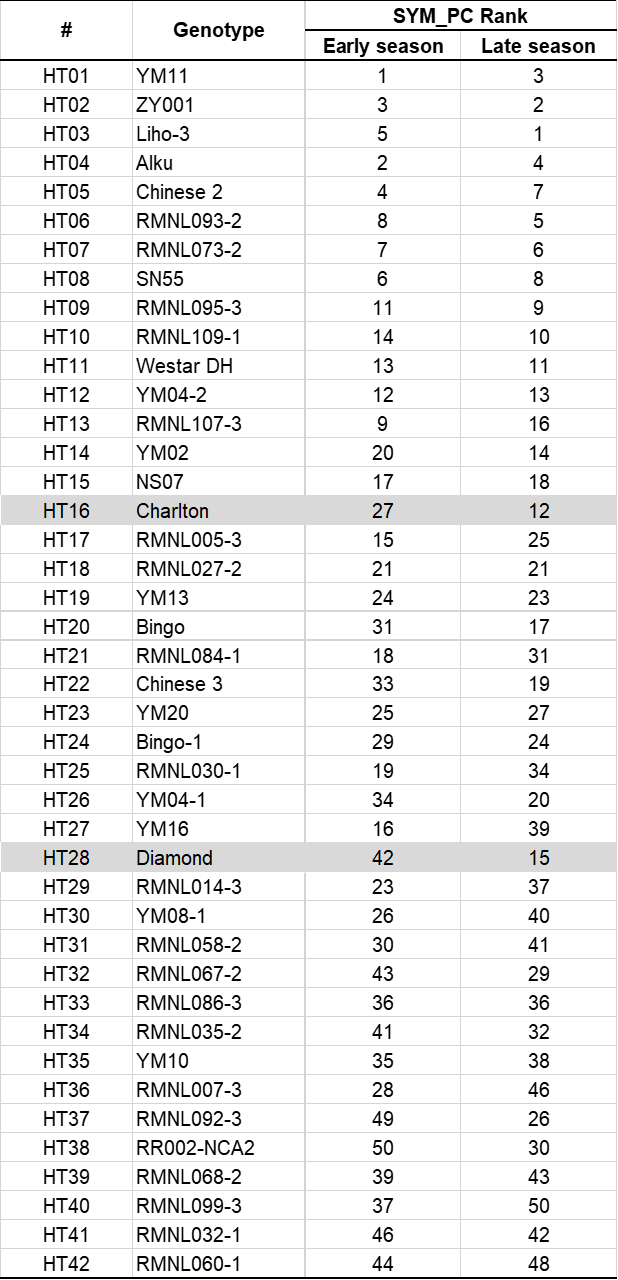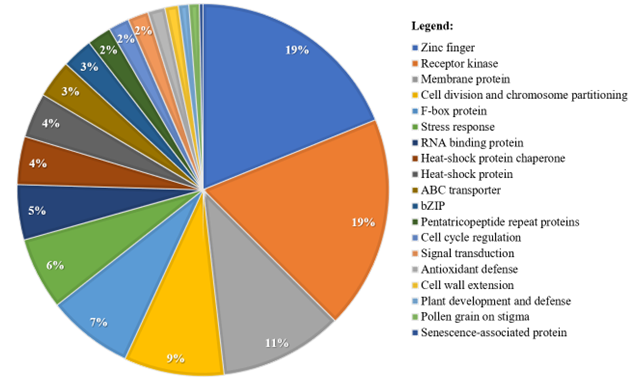Progress towards the discovery of genes for heat stress tolerance in a diverse canola population
Progress towards the discovery of genes for heat stress tolerance in a diverse canola population
Author: Sheng Chen, Aldrin Cantila, Suman Rakshit, John Quealy, Jacqueline Batley, Kadambot H. M. Siddique and Wallace A. Cowling | Date: 28 Feb 2023
Key messages
- Three hundred and twenty-three genotypes from a genetically diverse Brassica napus population were screened for heat stress tolerance using a prototype heat screening facility at The University of Western Australia (UWA) over two years with early and late sowing.
- 90k SNP Brassica chips were applied for genotyping and 41,907 polymorphic SNPs were used for molecular genetic analysis.
- Genome wide association studies identified 34 QTLs, from which 334 candidate genes are potentially related to heat stress tolerance. When the functions of these genes are confirmed by a multi-omics approach, the genes could be used in genomic selection for improving heat stress tolerance in canola breeding programs.
Introduction
Extreme heat events are occurring more frequently in Australia (Bureau of Meteorology 2022). Canola seed yield in Australia is negatively correlated with the number of days above 30°C during the flowering period (Dreccer et al 2018).
Previous research on heat stress in several Brassica species has shown that heat stress caused flower abortion, pod abortion and thus seed yield reduction (Annisa et al 2013; Chen et al 2019, 2021a). Heat stress tolerance is controlled by many QTLs distributed across the genome and dispersed in diverse genetic background (Chen et al 2022a). Heat stress showed negative effect on both male and female reproductive organs in Brassica napus (Chen et al 2021b). Based on these findings, we established a protocol for heat tolerance screening and constructed a prototype heat screening facility (HSF) at UWA (Chen et al 2021c). To validate the heat stress effect under field conditions, we extended these studies to the field in portable heat chambers (Uppal et al 2019) and with delayed sowing in national multi-environment field trials (Chen et al 2022b).
This paper reports the progress in the heat tolerance phenotyping using the prototype HSF at UWA for the discovery of candidate genes related to heat stress tolerance in canola.
Aims
This research uses a coordinated multidisciplinary approach for improving canola heat tolerance. The aims are to provide promising heat-tolerant materials and breeder-friendly protocol/methodologies to accelerate the future commercial release of heat tolerant canola varieties in Australia.
Method
Heat tolerance phenotyping
Three hundred and twenty-three genotypes were assessed for heat tolerance at UWA’s Field Station at Shenton Park, Western Australia (31°56′54′′ S, 115°47′44′′ E). In the prototype HSF (Chen et al 2021c), 200 genotypes were assessed for heat tolerance in 2020 and 210 genotypes were assessed in 2021. There were 87 genotypes in common across both years. In this experiment, two environments were related to sowing timings: the early season was sown in mid-April and the late season was sown in early June.
The genotypes were randomised in heat treatment pairs, i.e., pots with different heat treatments were placed side-by-side for a given genotype. All genotypes were evaluated for heat tolerance at 25⁰C day/15⁰C night as control treatment and at 32⁰C day/22⁰C night as heat stress treatment for seven days from the date of first open flower. All plants were harvested at maturity.
Five traits were measured based on main stem: seed yield on main stem, pod number on main stem, seed number on main stem, seed number per pod and 100-seedweight on main stem. Three traits were measured based on whole plants: seed yield on whole plant, above-ground biomass and harvest index. All the traits were analysed using linear mixed effects models. Stress tolerance index (STI) and percentage change (PC) across eight traits were used to determine the heat tolerance/sensitivity level.
Genome wide molecular analysis
Single nucleotide polymorphism (SNP) genotyping was performed using the Illumina Infinium 90K Brassica SNP chips (Clarke et al 2016). Genome-wide association study (GWAS) was done using the genomic association and prediction integrated tool (GAPIT) v3.0 R package (Wang and Zhang 2021).
Significant SNPs with ≥ 5% phenotypic variance explained, derived from the GAPIT v3.0 package, was used for QTL delineation. A QTL was defined either as a 100kb upstream or downstream region of each significant SNP (Anderson et al 2020) or a region with two significant SNPs located ≤15 Mb from each other on the same chromosome (Martínez-Montes et al 2018), also integrating a 100kb region upstream and downstream from the SNP.
Within the QTLs, genes were identified in B. napus cv. Darmor bzh v4.1 reference and the protein sequences of these genes were gathered using Geneious R10 (Kearse et al 2012). The putative function of each gene was then determined using CDD/SPARCLE (Lu et al 2020). QTLs and genes with putative functions related to heat stress were then physically mapped to B. napus cv. Darmor bzh v4.1 using MapChart 2.32 for comparison (Voorrips 2002).
Results
Heat tolerance of 323 diverse genotypes
Heat stress showed significant genetic variation for all five main stem traits i.e., seed yield, pod number, seed number, seed number per pod, and seed size (at <0.001) and also for harvest index (at <0.01). The results were very consistent between early and late sowing, and the combined data analysis in 2020 and 2021 identified 42 heat-tolerant genotypes ranking in the top 50 among 323 genotypes based on the percentage change of seed yield on main stem (SYM_PC) (Table 1).
Diamond, an Australian canola hybrid cultivar with good adaptation in heat-prone regions, gained the rank of 28th. Charlton, an Australian conventional cultivar, was ranked 16th. There were 15 genotypes, including 7 resynthesized B. napus genotypes created from India, 5 genotypes from China and 3 genotypes from other sources, showing better heat tolerance as reflected by SYM_PC.
Candidate genes related to heat tolerance
A total of 41,907 polymorphic SNPs among 323 genotypes were used for GWAS analysis. These SNPs identified 34 QTLs associated with heat tolerance as measured by stress tolerance index and percentage change of each of eight traits measured. A total of 1,374 genes were found in these QTLs and 334 candidate genes were possibly related to heat stress tolerance.
They are related to zinc finger (19%), receptor kinase (19%), membrane protein (11%), cell division/chromosome partitioning (9%), F-box protein (7%), stress response (6%), RNA binding protein (5%), heat-shock protein chaperone (4%), heat-shock protein (4%), and ABC transporter (3%), respectively (Figure 1).

Table 1. List of 42 heat-tolerant genotypes ranked within the top 50 (of 323 genotypes) based on the percentage change in seed yield on main stem (SYM_PC) from control to heat stress treatments in the early and late seasons of 2020 and 2021

Figure 1. Classification of candidate genes within the QTLs of this study. The percentage of possible function/domain group associated with heat stress are indicated. Pie segments without percentage values indicate ≤1% of the total genes.
Conclusion
Using the prototype heat screening facilities at UWA, we screened 323 B. napus genotypes over two years in both early and late canola seasons. About 5% of the genotypes showed better heat tolerance than Australian canola cultivars based on the response of the genotypes to heat stress versus control conditions. These genotypes are now undergoing two years of validation in national field trials across four different sites. The bona fide heat-tolerant genotypes will be delivered to Australian canola breeders in 2024. We identified 334 candidate genes possibly related to heat stress tolerance.
Once the functions of these genes are confirmed by a multi-omics approach, they could be used in genomic selection for improving heat stress tolerance in canola breeding programs. This GRDC-funded project paves the path for identification of heat tolerant germplasm and the future breeding and release of improved canola cultivars for the benefit of Australian canola growers.
Acknowledgments
This research was primarily supported by GRDC-funded national project “Improving canola heat tolerance — a coordinated multidisciplinary approach” (UWA1905-007RTX). UWA and NSW DPI co-funded this project.
References
Anderson R, Edwards D, Batley J, Bayer PE (2020) Genome‐wide association studies in plants. eLS:1-7.
Annisa, Chen S, Turner NC, Cowling WA (2013) Genetic variation for heat tolerance during the reproductive phase in Brassica rapa. Journal of Agronomy and Crop Science 199:424–435.
Bureau of Meteorology (2022) Australian climate variability & change - Time series graphs. Website: http://www.bom.gov.au/cgi-bin/climate/change/timeseries.cgi?graph=tmean&area=swaus&season=0112&ave_yr=0. Accessed on 28/02/2022.
Chen S, Guo Y, Sirault X, Stefanova K, Saradadevi R, Turner NC, Nelson MN, Furbank RT, Siddique KHM, Cowling WA (2019) Non-destructive phenomic tools for the prediction of heat and drought tolerance at anthesis in Brassica species. Plant Phenomics 2019:1-16.
Chen S, Stefanova K, Siddique KHM, Cowling WA (2021a) Transient daily heat stress during the early reproductive phase disrupts pod and seed development in Brassica napus L. Food and Energy Security 2020; 00:e262. doi: 10.1002/fes3.262
Chen S, Saradadevi R, Vidotti MS, Fritsche-Neto R, Crossa J, Siddique KHM, Cowling WA (2021b) Female reproductive organs of Brassica napus are more sensitive than male to transient heat stress. Euphytica 217:117. doi: 10.1007/s10681-021-02859-z
Chen S, Stefanova K, Siddique KHM, Cowling WA (2021c) Pre-breeding canola for heat stress tolerance – a prototype facility for large-scale screening at flowering stage. GRDC Grains Research Update, Perth, 22-23 February 2021.
Chen S, Hayward A, Dey SS, Choudhary M, Witt Hmon KP, Inturrisi FC, Dolatabadian A, Neik TX, Yang H, Siddique KHM, Batley J, Cowling WA (2022a) Quantitative trait loci for heat stress tolerance in Brassica rapa L. are distributed across the genome and occur in diverse genetic groups, flowering phenologies and morphotypes. Genes 13(2):296. doi: 10.3390/genes13020296
Chen S, Uppal R, Rakshit S, Quealy J, Bromfield J, Napier T, Dunn M, Siddique KHM, Cowling WA (2022b) Canola pre-breeding for heat tolerance: from controlled environment facility to the field. GRDC Grains Research Update, Perth, 8 March 2022.
Clarke WE, Higgins EE, Plieske J, Wieseke R, Sidebottom C, Khedikar Y, Batley J, Edwards D, Meng J, Li R, Lawley CT, Pauquet J, Laga B, Cheung W, Iniguez-Luy F, Dyrszka E, Rae S, Stich B, Snowdon RJ, Sharpe AG, Ganal MW, Parkin IAP (2016) A high-density SNP genotyping array for Brassica napus and its ancestral diploid species based on optimised selection of single-locus markers in the allotetraploid genome. Theoretical and Applied Genetics 129:1887-1899.
Dreccer MF, Fainges J, Whish J, Ogbonnaya FC, Sadras VO (2018) Comparison of sensitive stages of wheat, barley, canola, chickpea and field pea to temperature and water stress across Australia. Agricultural and Forest Meteorology 248:275-294.
Kearse M, Moir R, Wilson A, Stones-Havas S, Cheung M, Sturrock S, Buxton S, Cooper A, Markowitz S, Duran C, Thierer T, Ashton B, Meintjes P, Drummond A (2012) Geneious Basic: An integrated and extendable desktop software platform for the organization and analysis of sequence data. Bioinformatics (Oxford, England) 28:1647-1649.
Lu S, Wang J, Chitsaz F, Derbyshire MK, Geer RC, Gonzales NR, Gwadz M, Hurwitz DI, Marchler GH, Song JS, Thanki N, Yamashita RA, Yang M, Zhang D, Zheng C, Lanczycki CJ, Marchler-Bauer A (2020) CDD/SPARCLE: the conserved domain database in 2020. Nucleic acids research 48:D265-d268.
Martínez-Montes ÁM, Fernández A, Muñoz M, Noguera JL, Folch JM, Fernández AI (2018) Using genome wide association studies to identify common QTL regions in three different genetic backgrounds based on Iberian pig breed. PloS one 13:e0190184-e0190184.
Uppal RK, Brill R, Bromfield J (2019) Effect of heat stress on canola grain yield and quality. GRDC Grains Research Update, Wagga Wagga, 19 February 2019.
Voorrips RE (2002) MapChart: Software for the Graphical Presentation of Linkage Maps and QTLs. Journal of Heredity 93:77-78.
Wang J, Zhang Z (2021) GAPIT Version 3: Boosting Power and Accuracy for Genomic Association and Prediction. Genomics, Proteomics & Bioinformatics.
GRDC Project Code: UWA1905-007RTX,
